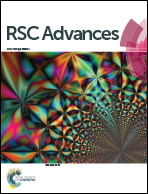Mesoporous assembled structures of Cu2O and TiO2 nanoparticles for highly efficient photocatalytic hydrogen generation from water†
Abstract
Photocatalytic water splitting to produce hydrogen using solar energy is a particularly attractive solution to increasing energy demands. However, to be of practical use, semiconductor electrodes need to be made of inexpensive, abundant elements and have a high, yet stable, photocatalytic H2-production activity. Here we report the first demonstration of 3D mesoporous networks of Cu2O and TiO2 nanoparticles as highly efficient photocatalysts for hydrogen generation from water. These assembled structures feature a highly accessible pore surface that exposes a large fraction of anatase TiO2 and Cu2O nanoparticles to electrolytes, and has a small grain size of the constituent nanocrystals, which lead to excellent activity for H2 evolution via a UV-visible light-driven reduction of protons. Catalytic results associated with optical UV-vis/NIR absorption and photoluminescence (PL) data indicated that the large separation of photogenerated electrons and holes at the Cu2O–TiO2 p–n junctions was the main reason attributed to the improved photochemical performance. Consequently, the mesoporous Cu2O/TiO2 catalyst containing ∼1.5 wt% Cu reaches an average H2 evolution rate of ∼542 μmol h−1 (or ∼36 133 μmol h−1 g−1) with an apparent quantum efficiency (QE) of 13.5% at 365 nm and an incident photon conversion efficiency of ∼4.1% under UV-visible light illumination (360–780 nm), which is one of the best HER activities among TiO2-based semiconductor systems reported to date.


 Please wait while we load your content...
Please wait while we load your content...